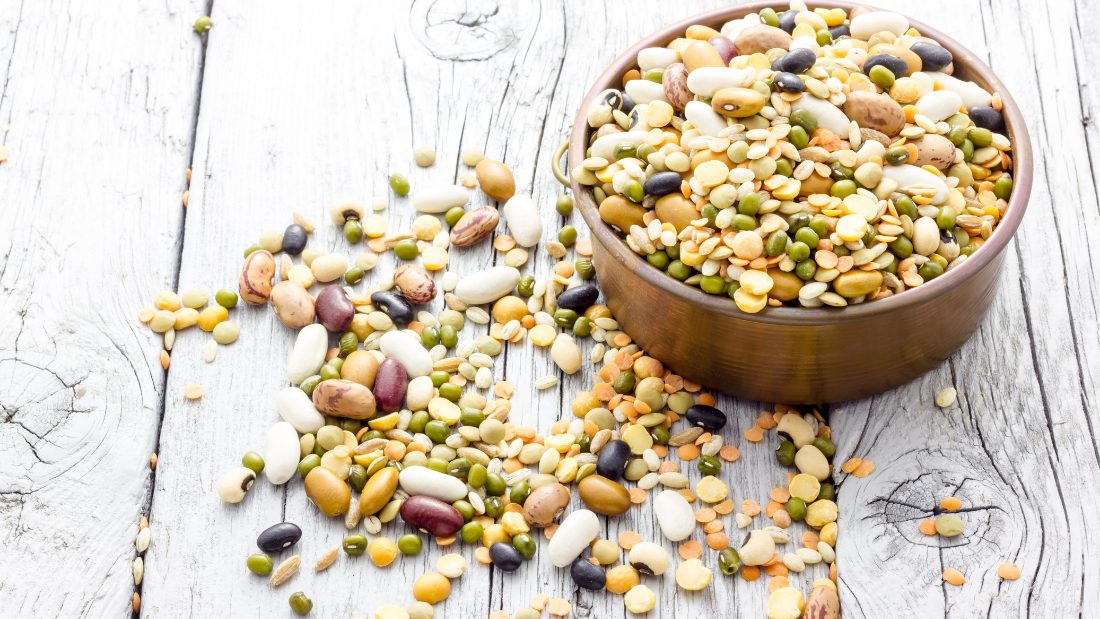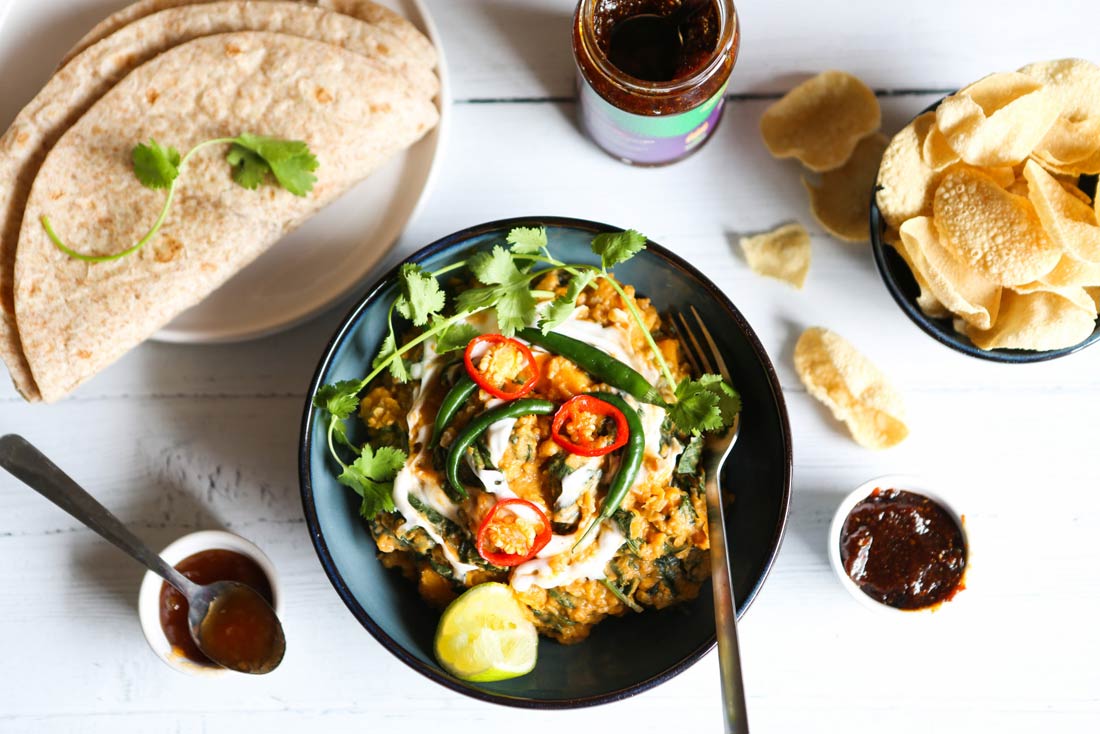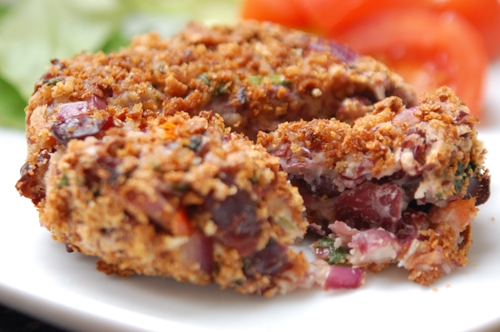The Quick Guide to Pulses – Beans, Lentils and Peas

Disease-busting little miracles
Pulses are high in protein, vitamins and minerals, low in fat, cholesterol-free, and a good source of fibre. They are also very cheap, particularly if bought dried. Their adaptability to a wide range of dishes is why they are one of the world’s key food staples. This feature
- gives ideas about which type goes best with which dish
- how to save money by cooking them from scratch
Beans and lentils are widely available in tins and pouches from all supermarkets and health food stores.
You can even buy UK varieties now, such as the Hodmedod tinned range.
Global inspiration
Just a few ideas to get you started…
Caribbean
- Black bean salad made from cooked black beans, fresh chilli, garlic, pineapple, mango and lime juice
Indian Sub-Continent
- Chana Aloo (chickpea and potato curry)
- Dahl – red split lentils or mung dahl (smaller, yellow split lentils)
- Muttar Panir (replace the usual curd cheese with tofu) to make this tofu and pea curry)
Italy
- Vegan Spaghetti Bolognese with lentils
- Minestrone – traditional Italian vegetable soup with added white beans eg haricot or cannellini
Mexico/Central America
- Enchiladas. For a very fast dinner, simply heat a jar of fajita sauce (eg Discovery brand), mash in some black or kidney and stir in some chopped red peppers. Serve with warm tortillas or wraps
- Chilli Hotpot with Black Beans, Lentils and Chocolate
Middle East/North Africa
Hummus and falafel – these make the basis of many a quick meal. Both are widely available ready-made or make them from our recipes. Serve with a drizzle of plain vegan yoghurt and sweet chilli sauce
Africa
Try our Gambian Peanut Stew with some added Beans and legumes!
Pulses also make great dips, sauces, burgers and such and can be mashed into pies with fresh herbs and other flavourings… the possibilities are endless. Or just blend them into soups and stews (particularly handy with fussy eaters)

For more recipes search the Vegan Recipe Club Bean link here – or find even more recipes and pressure cooker advice in Lorna Sass’s book Vegetarian Under Pressure (almost entirely vegan)
HOW TO COOK BEANS FROM SCRATCH
Preparation
- Ensure that they are cooked within the best before date on the packet, or use a shop with a high turnover. Old beans are tougher and take longer to cook.
- Rinse thoroughly – these days, most dried pulses are free of small stones but water will get rid of dust etc.
- Soak – see below for different methods.
- Drain the soaking water and rinse thoroughly.
- Cook in fresh water. Do not add salt, stock, sugar or tomatoes as this toughens beans/prolongs the cooking time. Such flavourings can be used when cooked pulses are added to a dish however.
Soaking Savvy
- Soak all pulses (not split lentils) for greater digestibility.
- Quick soak method – see link below.
- Long soak for eight hours or overnight in a cool place – particularly important in hot weather. Use a large enough bowl – they expand a lot when soaked – and enough water to cover by a few centimetres. Drain away the soaking water from the pulses and rinse well. Cook in fresh water, in either an ordinary saucepan or pressure cooker.
- Extended soak. If you find it hard to digest pulses (especially the larger beans), soak them for 2-3 days, ensuring you change the water twice a day (breakfast and dinner time!) until the beans are just starting to sprout. This breaks down the sugars that can lead to bloating. Then cook them as usual.
- Whole lentils. Soaking isn’t necessary but may make them more digestible. It also reduces cooking time (and fuel use!) quite substantially. 1-2 hours soaking is sufficient, but you can leave
them overnight if it’s easier. Split lentils don’t need soaking at all. - This article gives you the advantages and disadvantages of the main soaking methods.

Cooking times – regular saucepan method
The following chart gives approximate times in rough order of size, from small or split to large. Cooking times also depend on the age of the beans. Properly cooked beans should be tender but not too mushy.
Type of Pulse Soaking Time Cooking Time
Split lentils No soaking required 15-20 minutes
Split peas 2 hours minimum 30-35 minutes
Whole lentils 2 hours minimum 20-30 minutes
Whole lentils Unsoaked – but see note re digestibility 25-40 minutes
Mung/aduki beans 2 hours minimum 25-40 minutes
Black-eyed beans 6-8 hours or overnight 30-60 minutes
Flageolet /kidney/ 6-8 hours or overnight 1-1¼ hours
cannellini/pinto/black
beans
Chickpeas and other 6-8 hours or overnight 1-1½ hours
large beans
Soya beans 12 hours minimum 1½-3 hours
Pressure cooking method
Home freezing
If you cook one portion of pulses you might as well cook more. So, if you have the space, cook bigger batches and freeze in meal-size portions – use clean small plastic bags or boxes with lids. To freeze the equivalent of a tin of drained pulses, use a 400g/14oz clean empty tin as a guide, fill about three-quarters full, then transfer the contents to a bag or box. Defrost as usual, or in a microwave.
Bought frozen pulses
Peas, broad beans and fresh soya beans (edamame) are all useful to have in the freezer. Edamame – sold in large supermarkets and health stores – are very high in protein as well as being a beautiful bright green colour – and delicious in salads or stir-fries.

IMPORTANT: Pulse Safety!
While pulses are one of the most healthy and unprocessed foods available, there are a few important guidelines to follow.
- Rinse beans and change the water if soaking longer than overnight
- Cook beans thoroughly, especially kidney beans. Most large dried beans contain a naturally occurring toxin called lectin or phytohaemagglutinin. This is naturally destroyed in cooking, but if not done so, is likely to trigger nasty food poisoning. Lectin is contained in: kidney beans, cannelini beans, black beans, haricot beans and butter beans. Soya beans don’t contain lectin, but do need to be soaked and cooked thoroughly.
- Boil such beans vigorously for 15 minutes before you reduce to a simmer. However, pressure cooking or ordinary boiling is fine
- Do NOT cook raw beans in a crock pot/slow cooker as this increases their toxicity! However, it IS safe to add pre-cooked beans to a crock pot or oven casserole, stew etc
- Do not sprout these type of beans
NB Whole or split lentils, chickpeas, mung beans and aduki beans are safe to sprout.

The author
This post was written by VRC Team
Vegan Recipe Club is part of the UK’s leading vegan charity, Viva!. We have hundreds of delicious vegan recipes; from easy weeknight dinners to showstopper desserts, and everything in-between! Keep your eyes peeled for new recipes each month developed by our expert team of foodies and from guest chefs too.
